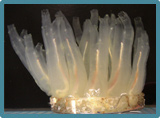|
Home> About Ciona intestinalis |
||
About Ciona intestinalis |
||
|
|
In addition to their unique evolutionary position as invertebrate chordates,
ascidians provide a simple experimental system to investigate molecular mechanisms underlying
development, reproduction, endocrinology, and physiology. In particular, their tadpole-type
larva, which has a notochord and a dorsal neural tube, represents the basic chordate body plan.
|
|
|
||
Japanese | English
|
|
||||||||||||||||||||||||||
|
Contact:
Resource Center :Shimoda Marine Research Center, University of Tsukuba |
|
Representative : Yasunori Sasakura |
 |
Copyright © 2012 NBRP-C.intestinalis. All rights reserved.


